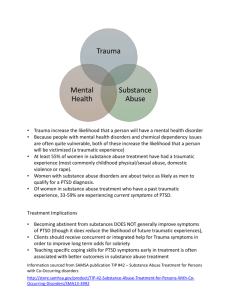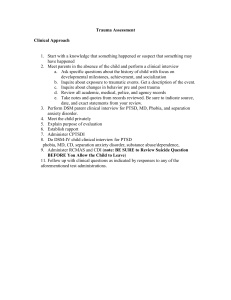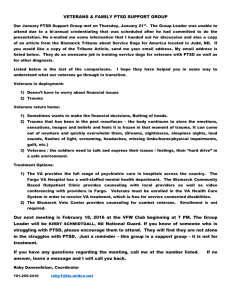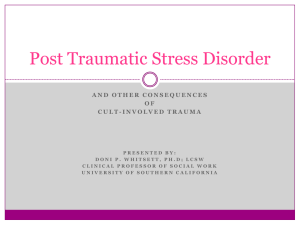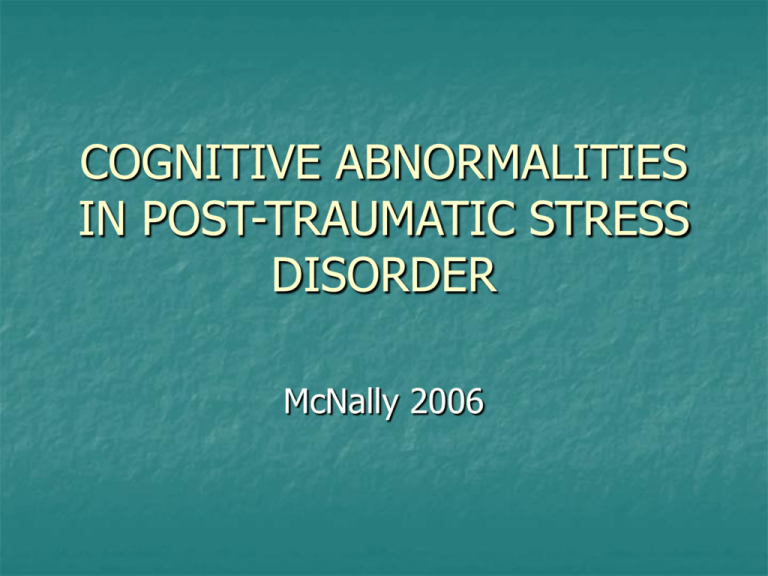
COGNITIVE ABNORMALITIES
IN POST-TRAUMATIC STRESS
DISORDER
McNally 2006
Some Basic Background
PTSD is an anxiety disorder that develops
usually in response to an overwhelmingly
terrifying, often life-threatening event
Its hallmark characteristic is the recurrent,
involuntary recollection of the trauma in
the form of intrusive thoughts,
nightmares, and vivid sensory memories –
i.e. they relive the trauma
Emotional Stroop Effect
Patients with PTSD take longer to name
the word colour when the coloured word is
related to their trauma
This task can be used to discriminate
genuine PTSD sufferers from those
malingering
Neural Mechanisms of ESE
Bremner et al used PET scans to show that women who
had sexual abuse-related PTSD, as opposed to victims
without PTSD, had less Anterior Cingulate Cortex
activation during the ES task
This finding was replicated by Shin et al using Vietnam
Veterans suffering PTSD
-also found PTSD participants to exhibit heightened
amygdala responses
Also found was that the smaller the anterior cingulate
cortex, the worse the severity of the PTSD symptoms
Other Consequences of PTSD
More difficulty concentrating and
remembering things in everyday life
Difficulty ignoring distracting information
IQ
It is thought that a lower IQ could result
in more severe PTSD
Studies (including twin studies on veteran
soldiers) show that a high IQ confers
higher resilience or protection against
developing PTSD following a severe
trauma
Hippocampal Volume
Gilbertson et al performed a study to show
that people with small hippocampi are
more vulnerable to developing PTSD
- Findings are supported with evidence
from twin studies
Progress and Controversy in the
Study of Posttraumatic Stress
Disorder
McNally (2003)
Research into anxiety disorders has
increased a lot since the 1980s
This article examines the most
controversial issues in the area of PTSD
The emergence of PTSD
First began with studies of soldiers. Shepard (2001)
found that after being subjected to events of war, normal
individuals were suffering from acute stress.
Lifton found that these symptoms remained.
Introduced into the DSM-III in 1995 after it was
suggested that other events e.g. natural disasters can
cause these symptoms
Definition: ‘stressor that would evoke significant
symptoms of distress in almost everyone’
3 aspects: re-experiencing (thoughts/flashbacks),
numbing (attachment problems) and miscellaneous
(sleep disturbance).
Conceptual bracket creep in the
definition of trauma
PTSD is unique in that it requires an event
(exposure to a traumatic event) as well as
behavior
Event does not have to be directed at the
individual, can develop PTSD by being shocked
by others’ experiences
Traumatic event does not have to be lifethreatening
Wakefield & Spitzer (2002) need to discriminate
genuine symptoms from normal distress
reactions e.g September 11th
Problems with the dose-response
model of PTSD
This model states that the PTSD symptoms
worsen as severity of stress increases
Proximity of individual to the epicentre of an
earthquake predicted severity of PTSD
symptoms (Pynoos et al 1993)
Although argued that the relationship is
complicated
May not be linear e.g. if reach maximum
severity, further exposure may not worsen the
symptoms.
Distortion of Recollection of
Trauma
In the trauma field experimenters rely on
retrospective self report of survivors
Recent studies have shown that a survivors
clinical state affects how they remember the
traumatic event
For example, Southwick et al. (1997) concluded that veterans with
higher PTSD scores “tend to amplify their memory for traumatic
events over time”
Traumatic memories, like autobiographical,
appear to be subject to alteration over time
The Spectre of the
“Phony Combat Vets”
Two main problem areas in studying Vietnam
veterans:
Deliberate exaggeration of symptoms in
Vietnam veterans to obtain the PTSD
diagnosis
“Phony combat vets” (Burkett & Whitley)
Men who claim to be suffering from combat related PTSD but
who either never saw combat, never served in Vietnam, or never
served in the military at all.
Burkett and Whitley believe that many studies of
combat-related PTSD are contaminated by the
inadvertent inclusion of subjects who have lied about
their combat trauma
For example: Keane et al (1998)
examined psychophysiologic reactivity to personalised audiotaped scripts
describing actual combat events
found those with past PTSD tended to fall midway between the other
groups with regard to physiologic reactivity
but approx a third had no physiological reaction to combat stimuli
McNally argues that men who volunteer for research
studies are from a different pool than those who have
caught the attention of Burkett and Whitley
Guilt, shame, & Trauma
The conditioning model implies that stressors cause
PTSD by producing toxic levels of fear, but it has
been shown that stressors can also traumatize
through causing guilt and shame.
This has been demonstrated among Vietnam
veterans (Breslau & Davis 1987).
Unlike fear, which can be experienced by rats, guilt
and shame are complex emotions which can only be
experienced by animals possessing a sense of self.
As the animal conditioning model reduces trauma to
its biological basis, it does not capture this uniquely
human aspect of trauma.
Risk factors for PTSD:
A large number of people are exposed to stressors, yet
very few develop PTSD.
There therefore must be risk factors that predict the
emergence of the disorder among those exposed to
trauma.
Some of these include low social support (although the
causal relationship is debateable), low intelligence,
neurological soft signs (non-specific behavioural
indicators of central nervous system impairment),
neuroticism, unstable family during childhood, preexisting mood or anxiety disorder, a family history of
anxiety or mood disorder and physical or sexual abuse in
childhood.
Several studies (e.g. Macklim et al 1998 & Silva
et al 2000) suggest that above average cognitive
ability may enhance an individual’s ability to
cope with stressors thereby buffering them
against developing PTSD.
Researchers have also identified peritraumatic
(i.e. during the trauma) variables that predict
later PTSD.
These include time distortion,
feelings of unreality, sense of bodily distortion,
emotional numbing, depersonalization, motor
restlessness, a sense of reliving the trauma and
elevated heart beat.
Can traumatic stress damage the
brain?
Cortisol is are released as part of the flight or
fight response in primates and although this
stress hormones facilitates defence in the short
term, prolonged cortisol exposure can cause
hippocampal damage.
Studies looking at Vietnam veterans and physical
and sexual abuse victims showed that their
hippocampi were smaller; this is evidence for
stress damaging the brain.
However, a study showed that urinary cortisol levels were the same
in Vietnam veterans and controls and yet hippocampal damage can
only occur in conditions of prolonged high levels of cortisol.
Recent neuroimaging studies have also provided additional data
against the theory that stress can shrink the hippocampus. For
example, Bonne et al (2001) showed that there was no difference in
hippocampal volume between PTSD patients and people not
suffering from PTSD.
In a recent landmark study, Gilberson et al may have decisively
refuted the hippocampal damage hypothesis. They found no
difference in size of hippocampus in monozygotic twins, one of
which had PTSD and the other of which didn’t. Gibertson et al came
to the conclusion that small hippocampi may constitute a preexisting vulnerability factor for PTSD among trauma exposed.
RECOVERED MEMORIES OF
SEXUAL ABUSE
Brown et al. (1998)
He stated that:
“Approximately a third of sexually abused victims report some
period of their lives where they did not remember anything about
the abuse and later recovered the memory of the abuse”
i.e. they have repressed the event
However, some scholars argue that there is no convincing evidence
that people can banish and then recover memories of horrific
experiences
McNally’s Criticisms of Brown et al.
(1998)
Inaccurate interpretation and presentation of the
following studies:
- DSM-III symptoms of non-specific memory impairment
- Dollinger (1985) – lightning strike study
- Wagenaar & Groeneweg (1990) – Nazi Holocaust
Camp experiences
- Williams (1994) & Femina et al (1990) – Sexual Abuse
example
Repressed Memory or bad
memory?
McNally states that it is not repressed memory that is
occurring in these cases but memories being recovered…
Biased – Why?
McNally performed a study on 4 participant groups and
found:
“repressed and recovered memory subjects do not exhibit a superior
ability to forget trauma-related words on a directed forgetting task,
contrary to hypothesis that they ought to be superior at blocking out
memory for material related to abuse”
Is this really proof against Brown et al’s recognition of
repressed memories in sexual abuse cases?
THE POLITICS OF TRAUMA
Example is of a child abuse study by Rind
et al (1998)
It was unanimously condemned on July
12th 1999 by members of the United
States congress for its alleged moral and
methodological flaws
Rind et al’s study…
Meta-analysis of 59 studies that had
addressed the long-term psychological
correlates of childhood sex abuse
Found that subjects who had been
sexually abused were nearly as well
adjusted and more resilient than their
non-abused counterparts
Consequences of this negative
publicity..
The American Psychology Association was
placed under extreme pressure and as a result
refuted the article
BUT…
Assessment by the AAAS found there to be “no
clear evidence of improper application of methodology or other
questionable practices on the part of the article’s authors”
This example highlights the balance that must be
maintained between science and politics..


